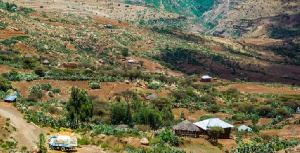 Tigray is a dry mountainous territory that has some of Ethiopia's most iconic historical sites
Tigray is a dry mountainous territory that has some of Ethiopia's most iconic historical sites
It is a little unfortunate that the circumstances under which many in the world would become acquainted with Tigray is that it is a troubled region in Ethiopia because its government is on a warpath with the Ethiopian government.
But it has to be said that Tigray is so much more than that. The beauty and mystique of the Tigrayan highlands deserve more than what some have called the region – a warzone. But if the Ethiopian does carry out his warning of marching into the regional capital Mekelle, the stories about Tigray will not be any better.
A 72-hour ultimatum given to the forces of Tigray People’s Liberation Front (TPLF) to surrender has so far gone unheeded. By the end of Wednesday, that period would have expired. Many analysts have predicted a civil war in Ethiopia which would have disastrous consequences beyond Tigray as Ethiopia overall, struggles to deal with ethnic tensions.
If a war does ensue, these are some of the unique features of the Tigray region and its people that would be negatively impacted.
Ancient Ethiopia lives in Tigray
The common era first millennium African empire of Axum, sometimes spelled Aksum, was located in present Tigray. At its height around the 1st century CE, Axum was a commercial hub influential in the trade between the Roman Empire and the East.
To date, archeologists continue to find evidence of the depth in greatness of Axum in the Tigray region. Coming before many other kingdoms in the East, Axum has been a source of pride for Ethiopians.
Technically, Ethiopia was never successfully colonized by an European country. This bit of history was because a serious of factors, including some that were out of Ethiopian hands, played into Ethiopia’s favor.
However, winning the decisive Battle of Adwa in 1896 during the First Italo-Ethiopian war was one of the Ethiopia did to ensure that it remained uncolonized. The intensity of the battle, as a result of the strength of the Italians, meant that if Ethiopian had not won in Adwa, we h=would have been speaking of a different kind of history.
Tigray is the home of Ethiopia’s oldest church
The Church of Our Lady Mary of Zion in Axum was built around the 4th century CE, however, it was destroyed at two separate points in the 10th and 16th centuries by the hands of Jewish and Islamic soldiers, respectively.
Notwithstanding, since the 17th century rebuilding of the church is upon the ruins of the 4th century church, Our Lady Mary of Zion is considered by many as Ethiopia’s oldest church. By virtue of its 1600-year existence, the church is one of the oldest anywhere in the world.
Small but mighty people
The region of Tigray, a vast hilly and arid area, is named after the Tigrinya-speaking Tigray people, Ethiopia’s fourth largest ethnic group who are less than 10% of the country’s people.
In spite of the relatively small number of Tigrayans in the country, the TPLF which represents the region and purports to represent the people, has shaped post-Cold War Ethiopia more than any other political organization in the ccountry.
In 1991, the TPLF led a coalition of militias and movements to overthrow the communist People’s Democratic Republic of Ethiopia. After that, the group was part of governing coalitions, and at a point produced a prime minister in the late Meles Zenawi.
Due to disagreements with Abiy Ahmed‘s Progress Party in 2019, the TPLF left his governing coalition.